- Details
- Category: Articles
“SomeKindHand” Pilgrimage Update (Number 1 of 2022)
Steve and Nancy Binks
As a way of commemorating the100th anniversary of the Great War, my wife Nancy and I set out in May 2012 to visit every burial ground and memorial in France and Belgium, where First World War servicemen were either buried or commemorated. In addition we vowed to stand at each headstone, read the serviceman’s name aloud, adding “Thank you”. The same act of remembrance would also be followed at the twenty two or so Memorials to the Missing; a collective “Thank you” added after each regiment, column, or panel, depending on the circumstances of the layout.
Over the following eight years, Nancy and I spent large chunks of our time travelling in our caravan and staying at local sites and renting gites in the winter months, in an effort to keep the Pilgrimage active all year round.
After a family bereavement, we returned home to North Wales in July 2018 until the spring of the following year when we started once again. We returned home in October 2019 with just a further 206 burial grounds to complete our Pilgrimage, and perhaps 6,000 burials and commemorations.
Covid was a blow to our plans; a false start in April 2021, led us to postpone any plans until the spring of 2022. We calculated that we needed about twelve weeks to complete our Pilgrimage. This seems excessive, however we are now towards the end of our Pilgrimage and what remains (with the exception of the department of the Marne) are the distant burial grounds where no British offensive took place, but Commonwealth servicemen are buried or commemorated. Although not exhaustive, casualties fall under the following circumstances: POW’s, RAF personnel, Red Cross staff, ship’s crews and military personnel, who were either killed in action, died at sea and then later their remains were washed ashore to be buried in the local cemetery. These 206 burial grounds contain around 6,000 casualties and will take us across four Belgian provinces and over fifty French departments, from the Atlantic sea to Cannes, to Strasbourg, to Bordeaux.
We set off on the 4th May. Thankfully having not booked our crossing before the unfortunate events at P&O, we went with DFDS, booking a week at the popular Jeugdstadion campsite, in walking distance to the Menin Gate. We had 25 sites to complete our Belgian Pilgrimage. The vast majority were communal cemeteries and churchyards in West Flanders, where the local citizens or the enemy had buried British casualties, in occupied territory.
This chapter of the Pilgrimage had got off to the worst possible start when the front passenger door of our minibus refused to open and the ordering of a new door lock (and a three day delay) at the VW dealership in Ypres failed to alleviate the problem!
After a delayed period in Ypres, we departed for the Ardennes, en route visiting the isolated burials of 23 servicemen in the communal cemetery at Houyet, dropping the caravan at a service station and doubling back.
Our chosen caravan site in the Ardennes was Douzy, just east of Sedan and from here we visited a further 15 burial sites, the vast majority containing POW casualties from the Battle of the Aisne (May 27th – June 6th 1918). The burial grounds included several French National Cemeteries (FNC), as described by CWGC, “Necropole” to the French. Many of these sites are no longer signposted or “pinned” on Google Maps! In addition we have been unable to use the very handy CWGC app, which marries cemetery burials with map location.
The mini heat wave we had so far experienced didn’t follow us to the department of the Marne, where on the 18th May we booked in o the municipal campsite at Epernay for seven days and a further 26 burial grounds and the last group of Commonwealth War Grave cemeteries remaining on our Pilgrimage.
Stepping out of the vehicle, locating the disabled access point for Nancy’s wheelchair, then handing her the cemetery register whilst I toddle off to my first plot, has been our life for almost ten years. Recognising that we were visiting the very last few CWGC cemeteries was a bit of a moment!
On Friday 20th May, we visited our last remaining CWGC burial ground with over 1,000 burials, Marfaux British Cemetery (1,129). In keeping with all our visits to British cemeteries in the Marne (on this current trip) Marfaux was yet another post Armistice cemetery with the vast majority of burials being those of XX11 Corps (51st (Highland) and 62nd (West Riding) Divisions) from the Second Battle of the Marne (15th July – 16th August, 1918). Marfaux also brought to a close our reading of the names of all Memorials to the Missing. With a collective “Thank you”, I read the names of the 10 servicemen of the New Zealand Cyclist Battalion, inscribed on a single stone panel of the covered shelter.
Three days later, we visited our last CWGC cemetery that I considered to be off the beaten track, Courmas British Cemetery, 207. Who knows how much we have spent in vehicle repairs over the years, attempting a journey regularly carried out by the gardeners and their vehicles!
At Bouilly Cross Road Military cemetery on the same day, I was surprised to see several known and unknown 1914 burials. After doing some makeshift gardening to unearth the officer’s epitaph, I was able to photograph the headstones of two serviceman who were separated by almost four years of war, as both had died during Battles of the Marne.
It’s not possible through time constraints or budget (whatever that is!) to spend idle time. Caravan arrival and moving days fall in to this category. The cost of fuel (a fraction under 2 euros when we arrived) has caused us to question the mileage undertaken from campsite to burial grounds and would necessitate more visits with the caravan in tow and “off grid” accommodation.
We departed Epernay on Wednesday morning 25th May, en-route to Verdun (Meuse), where we were due to arrive the following day. The journey included 6 burial grounds; 3 undertaken with the caravan attached and our first night off grid. Due to the Ascension Day (bank holiday in France), it became two days off grid, the second spent in the car park of the world famous sugared almond factory in Verdun (courtesy of the very helpful Verdun Tourism Office!)
Because of lost time in Ypres, we were unable to spend the three days that I had promised Nancy at the outset of our planning. We therefore spent the late afternoon on the Quai de Londres, taking in the sun in this lovely town. After which we drove the short distance to Glorieux FNC to say “thank you” to the two British casualties buried there.
The following day we drove the caravan to three sites, en route to our next campsite, Esche sur Azelette, just over the French border into Luxembourg. The last of these was at the communal cemetery in Lonwgy (Meurthe et Moselle), where I expected to encounter a few problems with one of the two casualties. It was detailed as a “special memorial”, on the CWGC site. Surprisingly I found both headstones, side by side, in a small French military plot, tucked in to the corner of the cemetery, behind some bushes. The burial ground of the French and British graves was in a sad state of neglect; a common occurrence in many village communal cemeteries since we moved from the Ardennes!
At Mareuil sur Ay, near Epernay, I was so upset with the neglect shown to the two unknown servicemen’s graves, I contacted my friend at CWGC headquarters in Beaurains to raise my concerns. I have been told to send in photographic evidence, and the local Marie will be contacted. (Away from the usual CWGC sites, French or Belgian local councils are responsible for the upkeep of the Commonwealth graves).
We then spent three nights in Luxembourg, visiting a further 7 sites, bordering Meurthe-Moselle and the department of Moselle.
By the end of almost four weeks, we have visited 77 of 206 sites and said “Thank you” to 3,387 servicemen. Tomorrow we move to Metz before we tackle the French-German border burials of Alsace Lorraine.
“We Will Remember Them”.
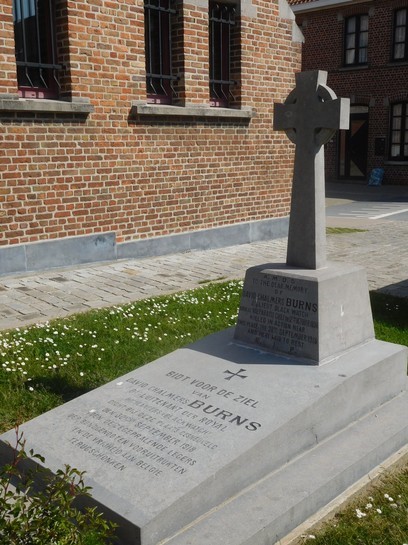
Our first visit. The plot of honour, outside the church at Slypskapelle, (west of Kortrijk) and the single grave of 2/Lt. David Burns, of the 8/Black Watch, who fell during the liberation of the town, 30th September, 1918. Born in Valparaiso, Chile, David was 19 years old.

German memorial, in St. Charles communal cemetery, Sedan. Erected in 1915, when it was much more substantial in size. Given the German occupation of Sedan during the Franco-Prussian war, it seems strange that the French would allow this memorial to remain, even though there are no longer any German burials. The cemetery contains 49 British servicemen, almost certainly POW’s.
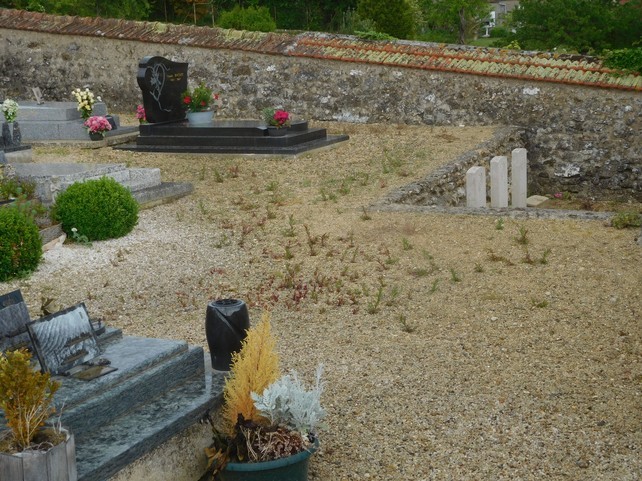
The graves of three servicemen in what I can only describe as a “pit” in the communal cemetery of Arcis le Ponsart, (Marne). The corner of the cemetery was being used as a dumping ground. Privates Nichols, Shillito (both AVC) and Sapper Picken (RE) deserve to remembered in a more dignified way than this!
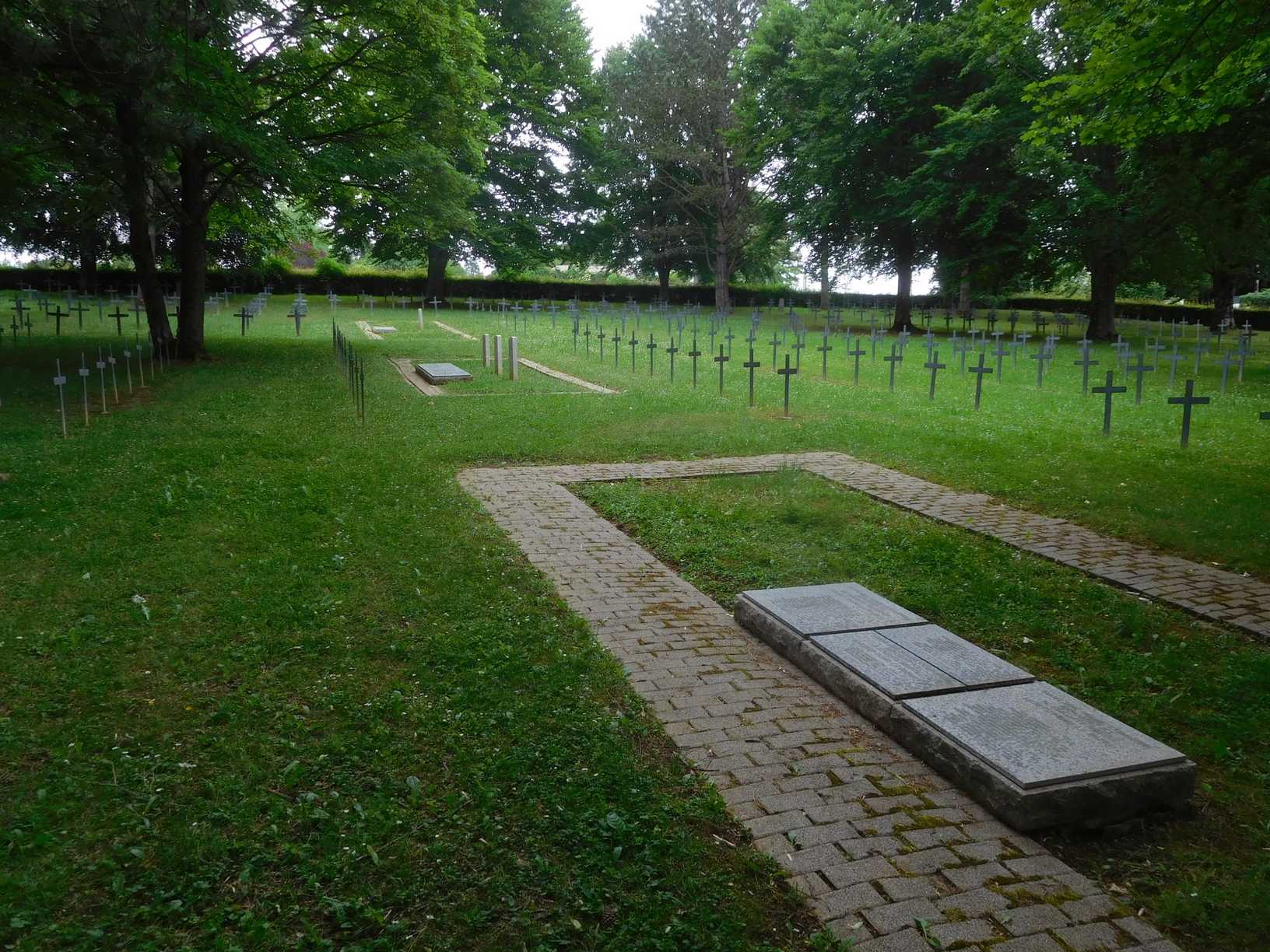
The four headstones of British servicemen erected adjacent to the ossuaries that hold their remains at Montmedy German Cemetery.
- Details
- Category: Articles
In memory of my beloved husband Hugh Rowlands D.S.O. M.C. of this town
2nd Lieutenant (Acting Captain) Hugh Rowlands DSO MC and Bar, London Regiment
Born on 29th September 1883, Hugh was educated at Beaumaris Primary School before the Grammar School. He entered the North Wales Training College (now part of the University of Bangor) to train as a teacher. In 1906 he married Jeanie Marian Williams (born Jane Marian Williams), also from this area; the marriage was registered in Bangor.
In 1891 the family lived at 35 Wexham Street: Elizabeth Rowlands, head of the household and Hugh’s nain (grandmother) was age 70 and a Grocer; her son Hugh, age 36 was a Mason; her daughter in law, Elizabeth was 35; Hugh her grandson was 7, his younger brother John was 5, sister Margaret was 3 and Letitia 6 months.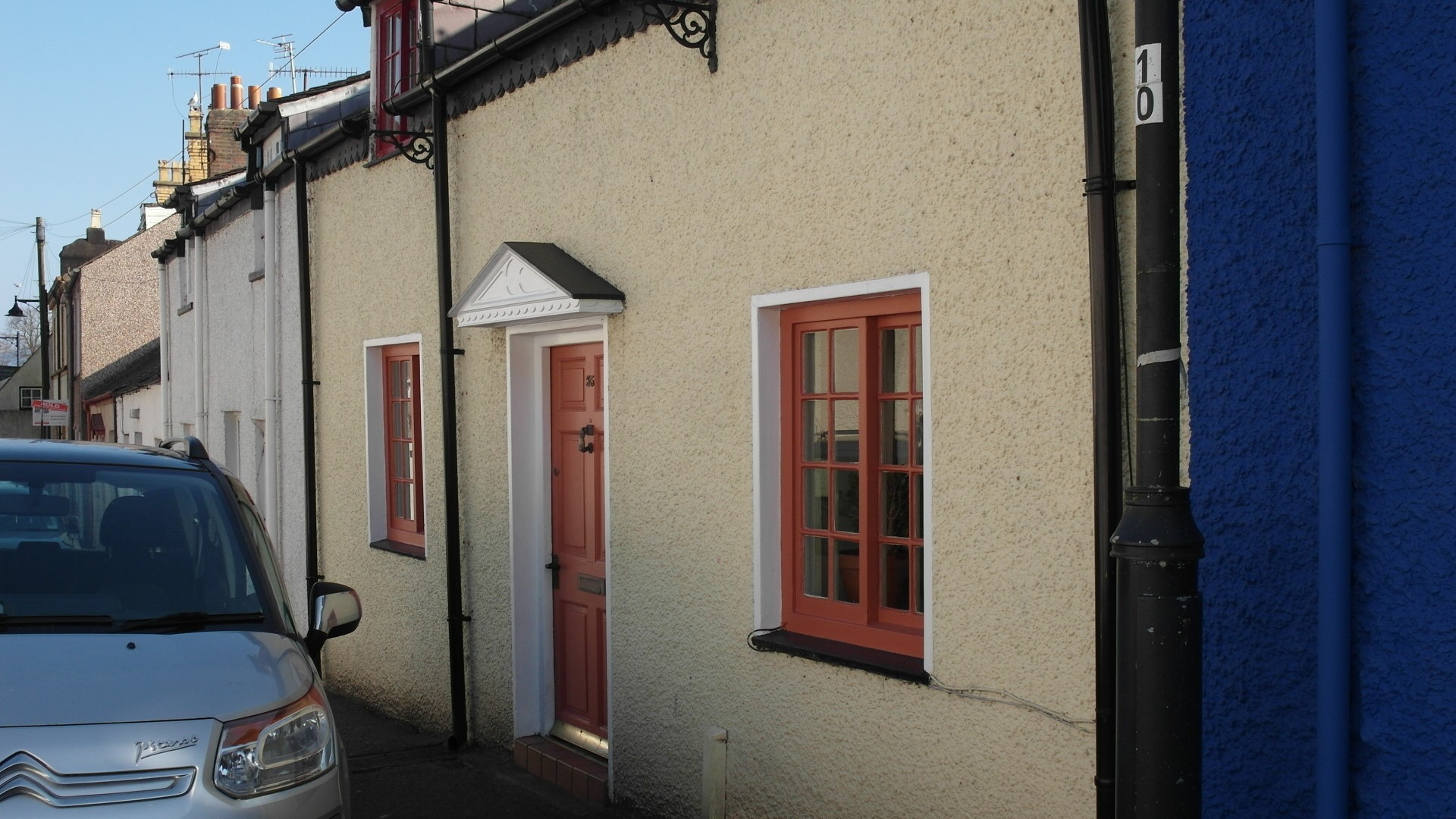
In 1899, there was a report in the North Wales Chronicle from: The Bangor School Board. - Pupil Teachers’ Centre Classes. - Mr R. W. Jones, the head teacher, reported that the attendance at these classes had been fairly regular. He submitted a list showing the result of the examination as follows (the names being in order of merit): Hugh was a 2nd year Pupil Teacher in the Bangor School Board area. In the same report, Violet Connington was in her 1st year (sister of Ernest Victor Connington who fought with the Canadians in the Great War and first cousin to William Connington who fought with the Australians, died in October 1918 and was buried on Church Island, Menai Bridge).
In 1901, still at 35 Wexham Street, Elizabeth was head of the household, now age 80 and a Grocer; his father Hugh age 46 was a Stone Mason; his mother Elizabeth age 45 born Llaniestyn; Hugh age 17, was a pupil teacher; John 15, was a Joiner Apprentice; Margaret 13, Lettice 10 and William 5 were scholars; Griffith, was 3 years old.
In 1911 Hugh and Jeanie (as Jane Marian) lived in The Cottage, Llaniestyn, near Pwllheli: he was a Schoolmaster; she was born in Bangor. They had a visitor, Simon Jones, another Schoolmaster, born in Tremadoc. Others in Hugh’s family were still at 35 Wexham Street: Elizabeth, now aged 55 and a widow had taken on the job of ‘shopkeeper and dairy keeper’; John, now 25, was a Labourer in a Limestone Quarry; Margaret, age 23, was ‘Teacher in a Council school’; Letitia, 20, helped with the dairy business; William, 15, also assisted in the dairy and Griffith, 13, was at school.
By 1914, at the age of 30, Hugh was Head Teacher at Llaniestyn County School on the Llŷn in Caernarfonshire. He was later Head of Capelulo School in Penmaenmawr, from which he resigned in 1938 on account of ill health after ‘contact with the poison gas that had been used in the Great War’.
Hugh enlisted as Private 17139, 13th Battalion Royal Welsh Fusiliers on 7th November 1914, his address was Belle Vue, Llaniestyn, Pwllheli. He later applied for a commission in the Welsh Army Corps – the correspondence is held in the Archives of the University of Bangor.
On 29th August 1915 Hugh Rowlands wrote to Evan Davies, Town Clerk for Pwllheli, asking for a favour: I am sure you know most of the Commanding Officers of the Battalions in the North Wales brigade, and have influence with them. I should feel greatly indebted to you if you could recommend me to some of them. It is signed: Hugh Rowlands, Headmaster of the Llaniestyn Cl. School until last Oct. when I enlisted.
Dated 3rd September there is a letter from Evan Davies to O. W. Owen Esq., Welsh Army Corps, Victoria Street, London. He is passing on a copy of Hugh Rowlands’ letter: I am sure he would make a good and reliable Officer. Will you kindly put forward his application in whatever Battalion you think his services would be appreciated?
On 4th September there is a response to Private Hugh Rowlands, 6th Platoon, 13th Battalion, R.W.F. Winnall Down Camp, Winchester, asking him to fill in the enclosed form.
Hugh’s handwritten reply is dated: Oct. 19th ’15 – I am very sorry I have not been able to send you my form sooner. We have had a change in the Command of the battalion a month ago, and since, have been on Salisbury Plan doing our firing. And he enclosed the form, duly completed. A copy of his application is also held, showing that his referee was ‘John Davies, Clerk in Holy Orders’ of ‘Llaniestyn Rectory, Pwllheli, N. Wales’. The final sheet, a certificate of medical fitness was signed on October 1st, 1915.
On 1st December 1915, as a Lance Corporal he sailed for France – on 4th January 1916, he was granted a commission in the 3/7 RWF, a Territorial Battalion.
In The London Gazette of 12th January 1916: The Royal Welsh Fusiliers. The undermentioned to be Second Lieutenants:- . . . Private Hugh Rowlands, from the Royal Welsh Fusiliers, to be Second Lieutenant. Dated 4th January, 1916.
In November 1916, Hugh joined the London Regiment, along with 8 other RWF officers. He was with the 1/2nd Battalion London Regiment on the Western Front. From the Regimental History of the 2nd Londons – 18th March, 1917 Hugh Rowlands commanded fighting at Baurains. On April 11th he: . . . did extremely good work in getting his platoon forward, displaying great bravery and initiative (attack on Heniel).
And on 18th July 1917, a citation for a Military Cross: 2nd Lt. Hugh Rowlands, R. W. Fus., attd. Lond. R. - For conspicuous gallantry and devotion to duty. Accompanied by an N.C.O., he crawled over 100 yards in front of our lines and captured three enemy snipers from shell-holes. By this fine act he removed a very serious menace. He has consistently done fine work throughout.
On the 25th November 1917, Officer in Charge A Company: . . . was ably supported by Lt Rowlands, who, together with all available men from Battalion HQ, and with a plentiful supply of bombs, had been sent up by Lt Col Sneath at the psychological moment . . . Germans forced out of their support line . . . capture and held by 1/2 Londons (Bar to MC).
On 6th November 1918: commanding B Coy crossing the River Honnelle. . . . and only about 30 men were assembled on the far bank, Rowlands commanding. Completely isolated and subject to counter attacks and at one point the enemy appeared behind them. They called on the Londons to surrender, but . . . Capt Rowlands' reply to this was delivered at the point of the bayonet; and by his gallant action he routed the Germans and put them to flight. Unfortunately he was forced to retire, and got all his men (wounded included) back safely (DSO Gazetted 10.12.19).
The citation for the bar to his Military Cross appeared in The London Gazette of July 2nd 1918 (a ‘bar’ is awarded when someone has won the Military Cross for a second or subsequent time): Lt. Hugh Rowlands, M.C., Lond. R. - For conspicuous gallantry and devotion to duty. Hearing that there were three wounded men in front of the line, he went out with another officer and three men and succeeded in bringing them in. He captured three enemy machine guns, though under fire from the enemy and our own protective barrage. Note in the margin: Nr. Moeuvres 15.11.17
He was given both the Military Cross and bar in a ceremony on 20th April 1918.
By the end of the war he was a Captain and company commander with the 1/2nd London Regiment; he had been Mentioned in Despatches no less than 8 times and awarded the Distinguished Service Order, Military Cross and bar.
The citation for his Distinguished Service Order was listed in The London Gazette of 10th December 1919: Awarded the Distinguished Order - Lt., (A./Capt.) Hugh Rowlands, M.C., 2nd Bn., Lon. R. At the Bois de Beaufort, near Angreau, on 6th November, 1918, for determined courage and leadership. Having lost all his platoon commanders and being held up by heavy machine-gun fire, he reorganised his company and the remnants of another company and got his force across a swollen river up to within 500 yards of the first objective, under very heavy fire. Though surrounded on three sides by the enemy, he eventually succeeded in fighting his way back across the river, bringing back with him all his wounded.
After all this gallantry, he returned to his former post at the school after the war, and had a short entry in Who's Who in Wales 1st edition of 1921, including: DSO, MC & bar, Served four years with the colours. He seems to have applied for his 1914-15 medals in 1924 from Belle Vue, Llaniestyn, Pwllheli. By 1939 he was resident with wife at Manora, Beaumaris, they were described as a Schoolmaster (Retired) and Housewife respectively in the 1939 Register.
Records confirm that Hugh Rowlands died at the age of 56, on May 16th 1940. His profession was given as ‘Elementary School Master (retired)’ the cause of death was ‘(a) Myo-carditis (b) Chronic Bronchitis’. His brother, G Rowlands (Griffith) of 42 Castle Street in Beaumaris reported the death. Hugh’s address was Manora, Penmon Road, Llanfaes, Beaumaris, Anglesey. Jeannie Marian Rowlands died in 1973, her death also registered in Anglesey.
With thanks to Dave Gallichan who told me of this grave; Clive Hughes and Stephanie Dummler for permission to quote their research; photo of 35 Wexham Street and headstone courtesy B Geoghegan; researched and compiled by Bridget Geoghegan
Memorials
His headstone in Beaumaris Cemetery reads: In memory of my beloved husband Hugh Rowlands D.S.O. M.C. of this town, died May 16, 1940, aged 56. The path of glory leads but to the grave. Also his loving wife Jeannie M. Rowlands. Died Aug. 28, 1973.
He is not an official war casualty.
- Details
- Category: Articles
John Jones
Ordinary Signalman, D/JX 170295, Royal Navy
John Jones was a career Royal Navy Signalman, at the time of his death he was serving on HMS Prince of Wales. From naval-history.net: She was laid down on 1st January 1937 and launched on 3rd May 1939. Build was completed on 31st March 1941 and had been delayed by approximately three months due to bomb damage. . . . During a Luftwaffe raid on the night of 8-9/8/40 a 250kg bomb (130kg of explosive), fell between the side of the fitting out basin and the ships port side in the vicinity of the after group of 5.25in guns. The bomb exploded underwater below the bilge keel. Buckling of the shell plating was caused for a distance of about 25ft, rivets were sprung and extensive flooding took place in the port outer compartments. The flooding was severe, due to the fact that final compartment air tests had not yet been made and the ship did not have her pumping system in operation. The water was pumped out by the local fire Brigade and the shipyard. The Prince of Wales was returned to dry dock for repairs. This bomb damage and the problems in the deliveries of her main guns and turrets delayed her completion.
And from Wikipedia: In her brief but storied career, she was involved in several key actions of the Second World War, including the May 1941 Battle of the Denmark Strait where she scored three hits against the German battleship Bismarck, forcing Bismarck to abandon her raiding mission and head to port for repairs. Prince of Wales later escorted one of the Malta convoys in the Mediterranean, and then attempted to intercept Japanese troop convoys off the coast of Malaya as part of Force Z when she was sunk on 10 December 1941, two days after the attack on Pearl Harbor.
Memorials
Churchyard of St Pedr, Llanbedrgoch: Er serchog gof am Margaret annwyl briod Richard Jones Tyn Giat, Llanbedrgoch a fu farw Rhagfyr 12 1975 yn 76 mlwydd oed. Hefyd eu hannwyl briod Richard Jones a fu farw Rhagfyr 3 1982 yn 82 mlwydd oed. Hefyd eu mab Sig. John Jones a gollodd ei fywyd ar HMS ‘Prince of Wales’ Rhagfyr 10 1941 yn 18 mlwydd oed.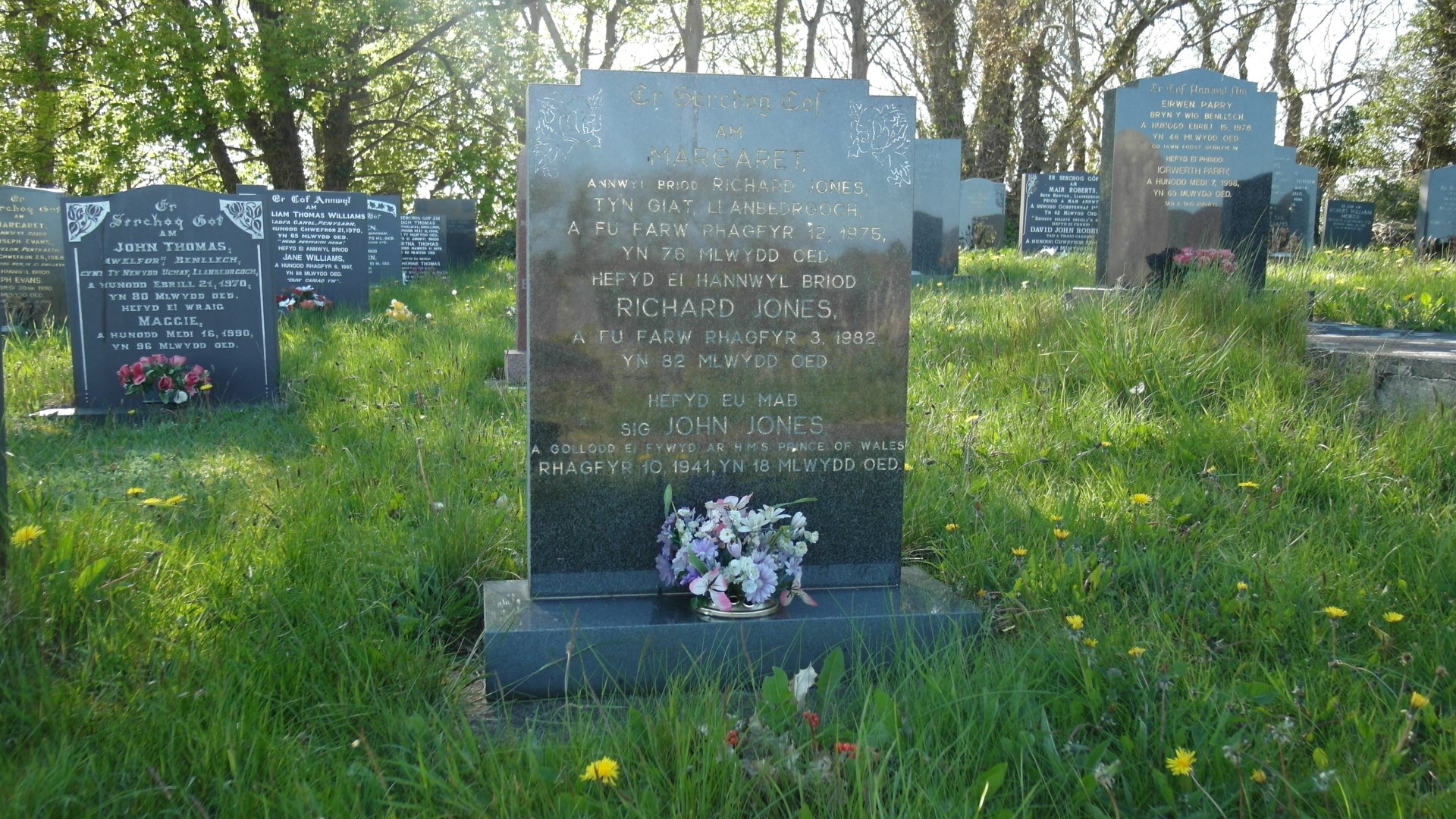
(Also their dear son, Sig. John Jones who lost his life on board HMS ‘Prince of Wales, December 10 1941 at the age of 18.)
naval-history.net: JONES, John, Ordinary Signalman, D/JX 170295, Prince of Wales, 10 December 1941, ship loss, MPK (Missing, Presumed Killed)
Commonwealth War Graves Commission: Ordinary Signalman John Jones - Service No: D/JX 170295 - Died: Wednesday 10.12.1941 - Aged: 18 - H.M.S. Prince of Wales Royal Navy - Son of Richard and Margaret Jones, of Tynygongl, Anglesey - Commemorated Plymouth Naval Memorial
The family grave is not yet recorded on The War Graves Photographic Project
Photograph of family grave, courtesy B Geoghegan
- Details
- Category: Articles
Benllech War Memorial: COMT. A.T.S. Gwyneth Rhianon Hughes Tyn-Cae.
Junior Commander Gwyneth Rhiannon Hughes Auxiliary Territorial Services, no 192738
Gwyneth’s parents were Elizabeth (née Roberts) and William Hughes. According to the family headstone, her father was a Minister. The birth of Gwyneth R Hughes was registered on Anglesey early in 1918; her death was registered early in 1946, in Aldershot, as ‘Gwyneth R Hughes age 28’.
There is a possible match in the 1939 Register for ‘Gwyneth Hughes at Oak Street, Gelli, Rhondda, born February 1918’, who was working as a Shop Assistant to a Draper. She was in a house with Henry Hughes (born 1872) and Maud Hughes (born 1901).
Some of her ATS career can be traced through The London Gazette. 17th December 1940: Auxiliary Territorial Service – The following list shows further officers appointed to the Auxiliary Territorial Service, together with their present substantive rank and the seniority of the dates shown:- Company Assistants. – 16th October 1940. – Miss Gwyneth Rhyannon Hughes.
1st August 1941: Auxiliary Territorial Service – The undermentioned to be 2nd Subs., 30th May 1941, with seniority as stated:- Miss Gwyneth Rhyannon Hughes (192738)
Also from the family headstone, both parents died within two years of Gwyneth, in spite of being comparatively young.
Memorials
In the churchyard of St Pedr, Llanbedrgoch: Er serchog gof am Elizabeth Hughes Tyn Cae a fu farw Hydref 1947 yn 54 mlwydd oed. Hefyd ei hannwyl briod Parch William Hughes a fu farw Rhagfyr 1948 yn 58 mlwydd oed. “Hedd perffaith hedd.” Also their beloved daughter Comt. A.T.S. Gwyneth Rhianon Hughes
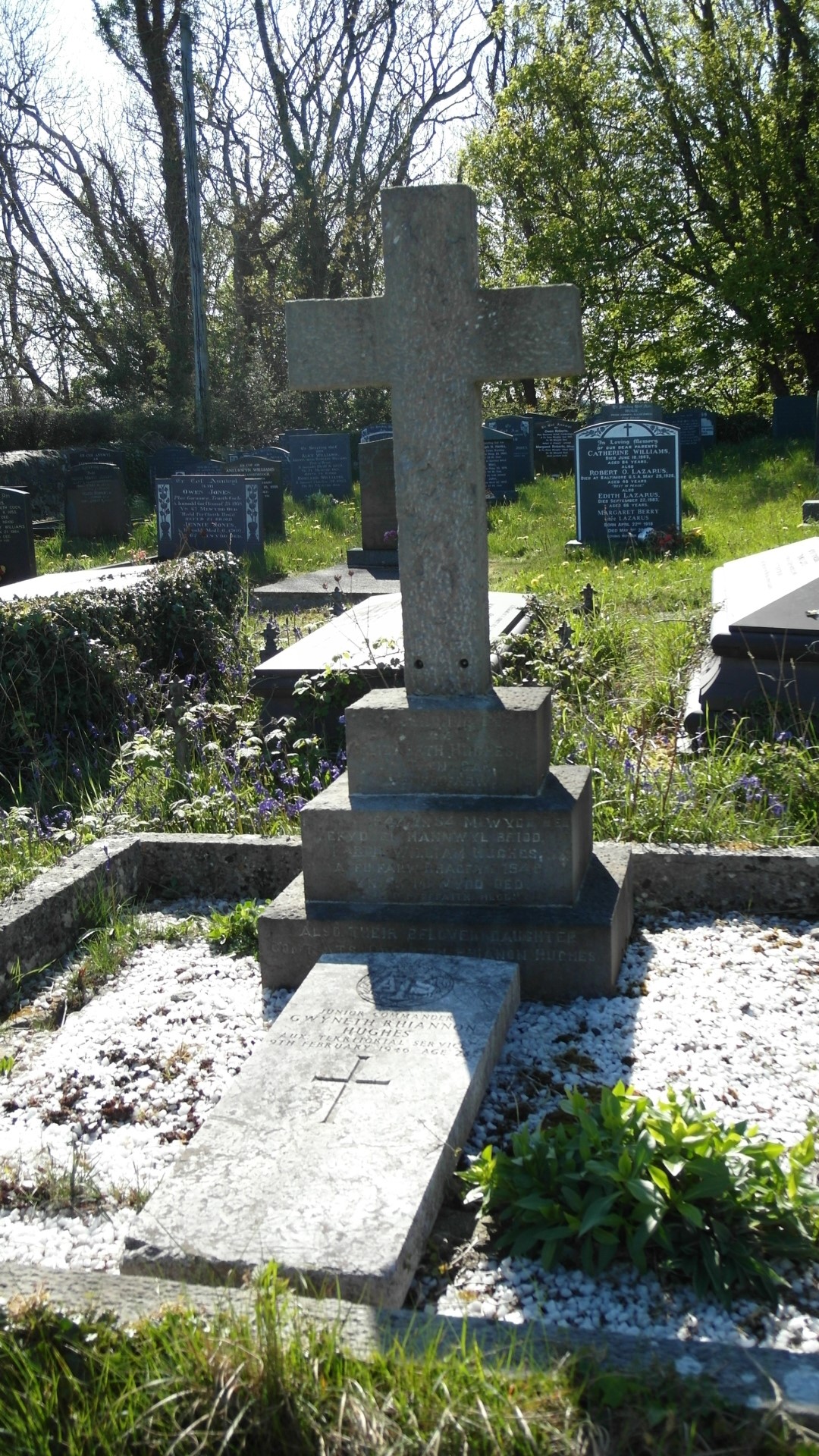
(In loving memory of Elizabeth Hughes of Tyn Cae who died October 1947 at 58 years old. Also her dear husband, Reverend William Hughes who died December 1948 at 58 years old. “Peace perfect peace.”)
A.T.S. Junior Commander - Gwyneth Rhiannon - Hughes - Aux. Territorial Services - 9th February 1946 aged 28
Benllech War Memorial: In Memoriam - Plwyfolion Gollwyd yn Rhyfel 1939 – 1945 . . . COMT. A.T.S. Gwyneth Rhianon Hughes Tyn-Cae.
There is a Memorial statue to those who served and died in the ATS at the National Memorial Arboretum, Alrewas, Staffordshire
Commonwealth War Graves Commission: Junior Commander Gwyneth Rhiannon Hughes - Service No: 192738 - Died: Saturday 09.02.1946 - Aged: 28 - Auxiliary Territorial Service - Daughter of William and Elizabeth Hughes of Pentraeth - Llanbedrgoch Churchyard
The War Graves Photographic Project: as for CWGC (twgpp.org)
Note: the variations of spelling ‘Rhiannon’ have been copied from the originals
Photograph of family grave courtesy B Geoghegan
- Details
- Category: Articles
Pentraeth WWII War Memorial: Cpl. Hugh Thomas, Bodhyfryd. R.A.S.C. Black Watch, Eidal, 1944.
Benllech War Memorial: Cpl. Hugh Thomas, Bodhyfryd
Hugh Thomas Corporal Royal Army Service Corps, No T/193631
From the CWGC website: On 3 September 1943 the Allies invaded the Italian mainland, the invasion coinciding with an armistice made with the Italians who then re-entered the war on the Allied side. Following the fall of Rome to the Allies in June 1944, the German retreat became ordered and successive stands were made on a series of defensive lines.
In the Apennines the last of these, the Gothic Line, was breached by the Allies during the Autumn campaign and the front inched forward as far as Ravenna in the Adriatic sector, but with divisions transferred to support the new offensive in France, and the Germans dug in to a number of key defensive positions, the advance stalled as winter set in.
Most of those buried in this cemetery died during the advance from Rimini to Forli and beyond in September-November 1944, an advance across one flooded river after another in atrocious autumn weather. The cemetery site was selected in November 1944 and burials were brought in from the surrounding battlefields. Cesena War Cemetery contains 775 Commonwealth burials of the Second World War.
Memorials
Llanbedrgoch Churchyard: Er serchog gof am Ann J. Thomas Bodhyfryd, o’r plwyf hwn a hunodd Rhagfyr 22 1948 yn 67 mlwydd oed. Hefyd ei hannwyl briod T. J. Thomas a hunodd Rhagfyr 9 1949 yn 76 mlwydd oed. Hefyd eu hannwyl fab Hugh Thomas (Cpl. R.A.S.C. Black Watch) a gollwyd yn Forli, Italy Tach 23 1944 yn 26 mlwydd oed.
(Also their dear son Hugh Thomas (Cpl. R.A.S.C. Black Watch) who was lost at Forli, Italy Nov 23 1944, at the age of 26.)
He is remembered on the Pentraeth WWII memorial, in the grounds of the Village Hall: Er Gogoniant I Dduw ac er gof bythol am fywydai ieuainc a dorrwyd i lawr trwy ac o ganlyniad i’r Ail Ryfel Byd 1939 – 1945 . . . Cpl. Hugh Thomas, Bodhyfryd. R.A.S.C. Black Watch, Eidal, 1944.
Benllech War Memorial: In Memoriam - Plwyfolion Gollwyd yn Rhyfel 1939-1945 . . . Cpl. Hugh Thomas – Bodhyfryd,
Commonwealth War Graves Commission: Corporal Hugh Thomas - Service No: T/193631 - Died: 23.11.1944 - Aged: 26 - Royal Army Service Corps - Son of Mr. and Mrs T. J. Thomas, of Pentraeth, Anglesey - Cesena War Cemetery, Italy - “Mewn Serchog Gof Byth Yn Anghof Mam, Tad a Dei. Bodhyfryd, Pentraeth, Sir-Fon” - Cesena War Cemetery, Italy